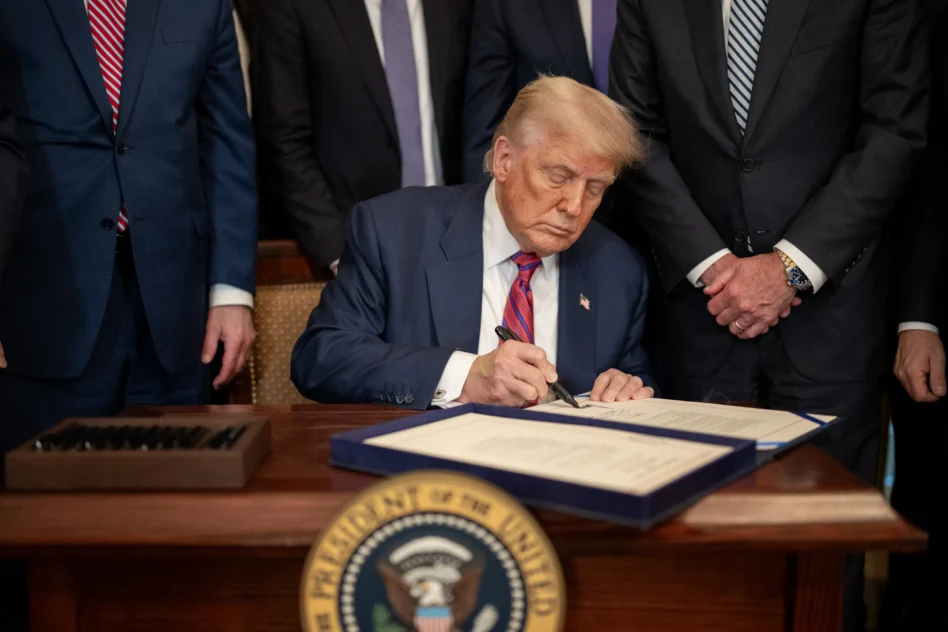In case you missed it, on Wednesday, President Donald Trump unveiled his “AI Action Plan” to slash red tape for AI development, promote the export of American AI, and counter “ideological bias” in artificial intelligence. Plus, there’s all that fun countering China stuff.
The plan is wide-ranging, but the 28-page document (paired with all of Trump’s AI-related executive orders) makes one thing clear: This administration views AI development as a critical matter of national security.
So we thought we’d do a bit of a deeper dive. Here’s where the plan touches on all the defense-y things we know and love.
AI for the DoD: The first big area that the plan touches on for defense is encouraging the adoption of secure AI tools across the DoD—with a special emphasis on models that are free of that pesky ideological bias.
“AI has the potential to transform both the warfighting and back-office operations of the DOD,” the plan writes, “The United States must aggressively adopt AI within its Armed Forces if it is to maintain its global military preeminence.
Here’s what the administration is calling for within the DoD:
- Building the talent base: Identify required AI skills and launch targeted training programs to meet force-wide needs.
- Standing up a test bed: Establish a DoD AI & Autonomy Virtual Proving Ground to scope and test AI systems at scale.
- Automating what matters: Map and prioritize key areas for AI automation—then transition them permanently.
- Securing compute access: Lock in deals with cloud and compute providers for wartime surge capacity.
- Training the next gen: Turn senior military colleges into AI hubs, integrating AI curricula across disciplines.
The plan also calls for DARPA to launch a program to build out AI interoperability. The DoD will also launch an “AI hackathon initiative to solicit the best and brightest from U.S. academia to test AI systems for transparency, effectiveness, use control, and security vulnerabilities.” Everyone loves a hackathon.
Build-up: A big focus of the plan is making sure that the US has the data centers, infrastructure, and compute capacity to power an AI-centric economy. For defense, that means building out compute capacity and centers specifically focused on military and intelligence needs.
- The government will adopt new security standards for AI data centers being used for intelligence and defense.
- The plan also pushes for more agencies to adopt classified compute environments for high-security AI.
- The administration also wants to revamp American semiconductor manufacturing, but we knew that.
Factories of the future: The plan even includes a whole advanced manufacturing section for you factory nerds out there.
- “It is crucial that America and our trusted allies be world-class manufacturers of…next-generation technologies,” the plan writes, “AI, robotics, and related technologies create opportunities for novel capabilities in manufacturing and logistics, including ones with applications to defense and national security.”
- The government will encourage the build up of advanced manufacturing capabilities using authorities including SBIR grants and the Defense Production Act.
Lock it down: The administration also seems pretty secured both about malicious actors accessing American AI, and the risks AI itself could pose to national security.
- The plan calls for the government to “collaborate with leading American AI developers to enable the private sector to actively protect AI innovations from security risks, including malicious cyber actors, insider threats, and others.”
- The US will also “evaluate frontier AI systems for national security risks in partnership with frontier AI developers.”
Biothreats: Interestingly, the plan also puts an emphasis on AI’s potential to increase biological threats, as well as to protect from them.
- AI “could create new pathways for malicious actors to synthesize harmful pathogens and other biomolecules,” the plan says.
- It calls for a “multitiered approach designed to screen for malicious actors, along with new tools and infrastructure for more effective screening.” Basically, using data and AI to make sure we don’t become victims of biological warfare. Fun.

